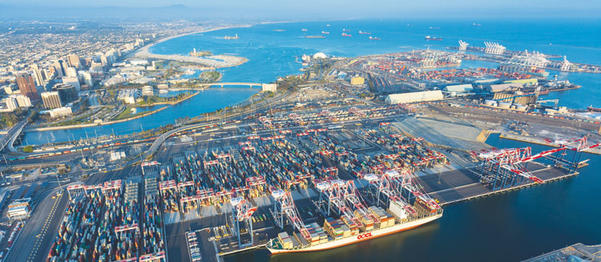The Port of Long Beach and the trade-related industries it supports employ approximately 30,000 people within the City of Long Beach. With more than $180 billion in goods passing through the port each year, trade-related companies tasked with moving, tracking and ultimately selling these goods support about 316,000 workers in the Southern California region and about 1.4 million jobs nationwide, according to the port.
The Port of Long Beach is on track to surpass 2017, its best year ever for cargo throughput. Overall cargo volumes through the port increased by more than 17% through the first four months of 2018.

When the redevelopment of Long Beach Container Terminal, pictured, is completed in 2020, the terminal alone will be able to handle 3.3 million twenty-foot equivalent units of cargo annually. If the terminal were itself a port, this figure would rank it as the nation’s fourth busiest port. (Photograph courtesy of the Port of Long Beach)
“We are on track to have the busiest year in our 107-year history, following up on our record result last year,” Mario Cordero, the port’s executive director, told the Business Journal. “The Port of Long Beach is not only the economic engine of this city, it’s a conduit for commerce for the nation and a vital trade link between the United States and China, the world’s two largest economies.”
Industries supported by international trade coming through the port include trucking, rail, customs and freight forwarding, warehousing, longshore labor, retail and other sectors. Operations within the port complex directly support as many as 16,000 jobs within the trucking industry alone, according to Weston LaBar, executive director of the Harbor Trucking Association.
Many companies base their operations in Long Beach due to its proximity to the harbor. Mercedes-Benz USA, for example, moved its western region offices, training facility and vehicle preparation center to Douglas Park in 2015 in part because its vehicles are shipped through the port. The cars are hauled to the Douglas Park facility where they undergo preparation for sale at dealerships throughout the Western United States.
There are 22 container and bulk cargo terminals within the Port of Long Beach. Its two largest container terminals are Total Terminals International, owned by Mediterranean Shipping Company, and Long Beach Container Terminal, owned by Orient Overseas Carrier Line.
The port has invested more than $4 billion into major capital improvement projects to improve its infrastructure and ensure its competitive edge in the future. One of its largest undertakings is the construction of a new cable-stayed bridge to replace the existing Gerald Desmond Bridge, which spans the entrance to the port’s inner harbor. Upon completion in 2019, the bridge will be the tallest structure in the City of Long Beach, with six lanes of traffic and a higher clearance for larger ships to pass beneath. Construction workers recently strung the first cable of the bridge, and the structure’s main span has begun to be moved into place.
The third phase of the redevelopment of Long Beach Container Terminal (LBCT) within the port’s middle harbor is currently underway, with an expected completion set for 2020. The project involves combining two aging terminals into one, installing electrified automatic equipment and constructing new buildings for LBCT. The first two phases of the project are operational, with some of the world’s largest, zero-emission cranes now daily moving cargo from ships to shore.
The port is also investing $1 billion in its rail infrastructure, with a major project planned to expand on-dock rail facilities at Pier B in the works, among other initiatives meant to transfer more goods movement from trucks to rail. These investments are a part of the port’s commitment to increase goods movement efficiency while reducing emissions.
Through its capital improvement projects, the port supports thousands of construction jobs. Several engineering firms retain operations in the area and work frequently with the port on these projects, including Long Beach-based P2S Engineering and Moffatt & Nichol.
Worldwide, the Port of Long Beach is known as “The Green Port” due to its comprehensive programs and initiatives aimed at improving air and water quality. Both the Port of Long Beach and the Port of Los Angeles have begun implementing the latest iteration of their joint Clean Air Action Plan, which calls for conversion of on-dock equipment to zero emissions by 2030 and conversion of trucks to zero emissions by 2035.
